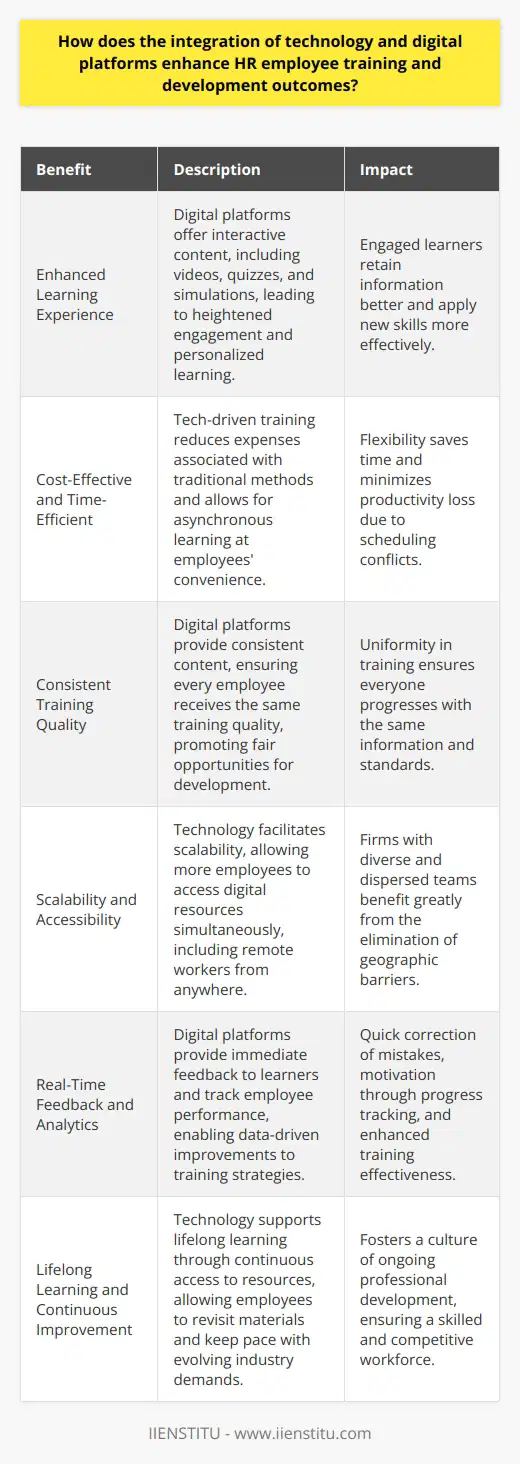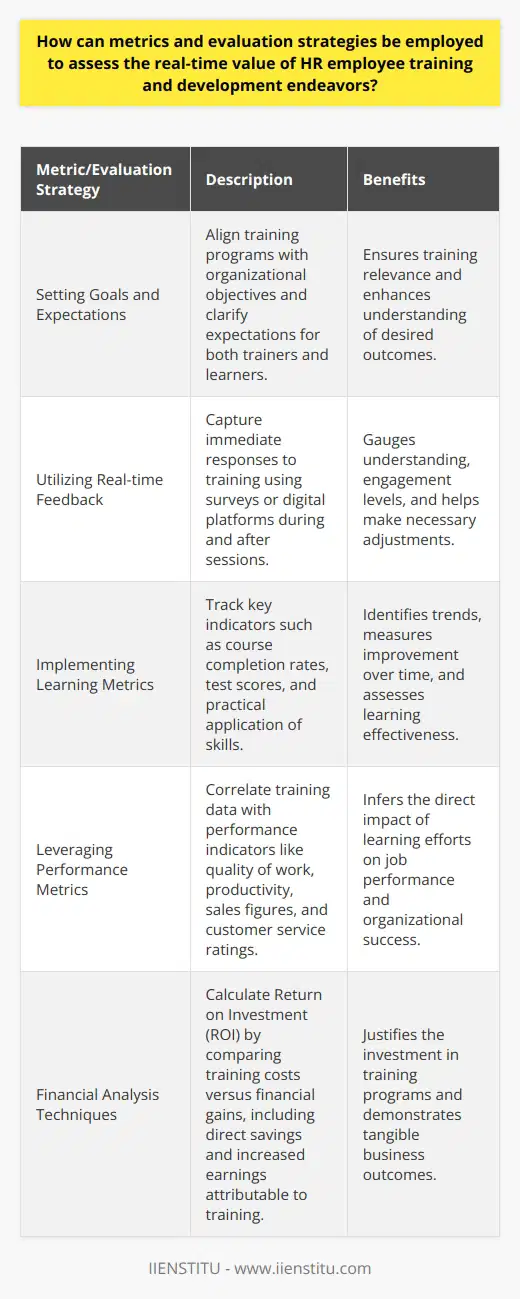
In the dynamic landscape of human resources management, the concepts of employee training and development have become indispensable tools for organizations intent on fostering a competitive edge in the market. Central to the strategic framework of HR, these practices not only enhance individual employee skills and capabilities but also contribute significantly to the overall operational efficiency of the organization. This academic treatise delves into the comprehensive study of HR employee training and development, expounding upon its myriad significances while offering examples and insights into its effective application in various professional environments. As companies vie to remain relevant amidst rapid technological and socioeconomic changes, a thorough understanding of these practices becomes even more paramount.
Introduction to HR Employee Training and Development
Employee training and development, within the domain of HR, involves a systematic approach to enhance an organization's workforce capabilities. Effective training is meant to align the skills and competencies of employees with the strategic needs of the company, thereby educationally enriching staff and bolstering organizational prowess. It is a proactive strategy to ensure that the workforce can meet current and future demands with dexterity and poise.
The importance of employee training and development in HR management can hardly be overstated. A well-crafted training program empowers employees with necessary skills to perform their responsibilities effectively while development programs prepare them for future roles and challenges within the company. This symbiotic growth not only benefits the individual but also fortifies the company's market position by nurturing a skilled and adaptable workforce.
This blog offers a comprehensive exploration of the facets of HR employee training and development, analyzing their indispensable roles in shaping a robust and skilled workforce. The content delineates various types and methods of training and development, underscores their significance, and probes the strategic processes involved in crafting effective training programs.
Importance of HR Employee Training and Development
Employee training and development are critical in elevating the collective productivity of an organization's workforce. Training equips employees with the practical skills necessary to perform their daily tasks efficiently, thereby directly impacting productivity metrics. Development programs engage more with the growth potential of employees, preparing them for higher responsibilities and more complex tasks, indirectly fostering a more productive work environment.
This investment in employees pays dividends in enhancing retention rates. By showing a commitment to their career progression and personal growth, organizations can improve job satisfaction and loyalty, which are pivotal in retaining talented staff. An environment that promotes growth and opportunity encourages employees to envision a long-term future within the company.
The continuous evolution of technology necessitates that employee training is an ongoing endeavor. It's important for companies to keep pace with the latest advancements, and regular training sessions ensure that employees are not left behind. This is particularly important in industries that are heavily dependent on technology, where the pace of change is notably swift.
Training vs Development: Understanding the Difference
The concepts of employee training often intersect with those of employee development, though they serve distinct purposes. Employee training typically refers to programs designed to improve an individual's performance in their current job role. It focuses on teaching new skills or enhancing existing skills to boost on-the-job efficiency and effectiveness.
Alternatively, employee development is a broader and more future-oriented strategy. It aims at the overall growth of the employee, preparing them for potential future roles and career advancement within the organization. This long-term approach often encompasses leadership skills, decision-making capabilities, and personal development.
Differentiating the two is critical for HR managers as it allows for a more targeted and effective approach to workforce management. Both employee training and development are essential elements of a comprehensive HR strategy, each addressing different needs within the employee life cycle.
Types of HR Employee Training and Development
The realm of HR employee training encompasses a diverse range of methods, each tailored to specific outcomes. On-the-job training, for instance, immerses employees in their work environment, promoting learning through direct experience. Off-the-job training, by contrast, removes employees from their day-to-day work tasks to focus on learning in a different setting, often using workshops or seminars.
Induction training is pivotal as it introduces new hires to the company culture, expectations, and their specific roles. It's essential for onboarding employees effectively and setting them up for success. Meanwhile, refresher training serves to update and re-energize existing employees' skill sets, ensuring that their knowledge remains current and applicable.
Employee development transcends mere skill acquisition, embarking on enriching the individual's career path through professional development (like earning an online certification course in their field), personal development (such as leadership and interpersonal skills), and career development (planning and pursuing a career trajectory within or outside the current organization). This holistic approach to enhancing an employee's professional journey is paramount for sustaining their engagement and motivation.
Considering Different Learning Styles in Training and Development
Learning styles are a significant factor in the efficacy of training and development programs. Understanding that each employee might have a preference for a particular mode of learning – whether auditory, visual, kinesthetic, or a combination thereof – is crucial for HR to tailor their methods accordingly.
Accommodating these varied learning styles can be challenging, but it's a vital consideration to ensure that training and development efforts resonate with every employee. Diverse training methodologies, involving a mix of lectures, interactive workshops, and hands-on activities, can cater to the full spectrum of learning preferences.
Steps in Designing Effective HR Employee Training and Development Programs
The conception of training programs starts with the identification of training needs, pinpointing specific skill gaps or performance issues within the workforce. This phase is crucial because it ensures that the program addresses real, tangible needs within the company.
Once needs are established, planning and designing the program involve setting objectives, choosing content, and delivery modes that are most likely to resonate with the targeted audience. It is at this stage that the incorporation of appropriate learning styles takes place, fleshing out a blueprint for an impactful training initiative.
The implementation phase is the crucible where theory meets practice. It's where trainers engage with employees, facilitating learning and ensuring that the program's objectives are met. This is a dynamic process that might require real-time adjustments based on participant feedback and engagement.
The Role of Technology in HR Employee Training and Development
The integration of digital tools into training methods opens a wealth of possibilities for HR practices. E-learning platforms allow for flexibility and accessibility, providing employees with the opportunity to learn at their own pace and on their own schedule. Digital simulations and virtual reality tools can also offer practical, immersive experiences without the associated risks or costs of real-world training.
However, the move towards digital learning platforms isn't without its challenges. There are considerations about digital literacy, access to technology, and the potential loss of the human interaction element that would typically be present in in-person training sessions. Yet, the opportunities provided by these advancements—such as the ability to attend an hr online course—offer significant benefits for both the organization and its employees.
Conclusion: The Future of HR Employee Training and Development
Employee training and development programs will continue to be a cornerstone of successful organizations. As the business landscape evolves, so too must the strategies employed to keep the workforce skilled and knowledgeable. The future likely holds more personalized, technology-driven training methods with an emphasis on continuous learning and adaptability.
With strategic foresight, HR practitioners should find themselves revisiting and optimizing their training and development programs regularly. By staying attuned to industry transformations and technological innovations, they can ensure that their workforce remains a step ahead, well-equipped to navigate the complexities of the modern business environment.
Frequently Asked Questions
What are the key considerations that significantly impact the effectiveness of HR employee training and development programs?
Key Considerations for HR Training Success
Alignment with Organizational Goals
Alignment drives program relevance. Organizational goals give training direction. Training must mirror company strategy. This ensures skill development supports business objectives.
Identification of Competency Gaps
Competency assessment is crucial. It pinpoints employee skill shortages. Training bridges these gaps. Organizations must understand employee weaknesses. This focuses development efforts.
Tailored Learning Paths
Individual needs vary. Customize training to meet them. Personalization enhances engagement. It respects diverse learning styles. Learners feel valued.
Leadership Involvement
Leaders must champion training. Their involvement motivates employees. Visible support reinforces training importance. Leaders guide and inspire learners.
Effective Content Delivery
Content delivery matters. Choose methods wisely. Diverse formats cater to various preferences. Include e-learning, workshops, mentorship. Mix methods for impact.
Continuous Learning Environment
Cultivate a learning culture. Encourage knowledge sharing. Continuous learning is key. It drives innovation, adaptability.
Evaluation and Feedback
Measure training effectiveness. Use qualitative and quantitative metrics. Feedback refines training. It adjusts for improvements. Evaluation ensures accountability.
Technological Integration
Embrace relevant technologies. It promotes interactive learning. Use Learning Management Systems (LMS). They track progress, provide resources.
Budget Consideration
Balance cost with quality. Don't skimp on essential resources. Budget planning is strategic. It allocates funds appropriately.
Scalability and Flexibility
Plan for organizational change. Ensure training programs can scale. Flexibility allows for adaptation. Training must grow with the company.
Regulatory Compliance and Ethics
Stay abreast of legal requirements. Ensure programs meet regulatory standards. Ethical considerations are paramount. Training content should reflect them.
Each consideration intertwines with others. They collectively shape program effectiveness. Businesses should weigh each carefully. Implementing these ensures a robust training framework. It fosters employee growth. It also aligns with strategic business goals.

How does the integration of technology and digital platforms enhance HR employee training and development outcomes?
The Role of Technology in Training and Development
Enhanced Learning Experience
Technology reshapes how employees engage with training. Digital platforms offer interactive content. This content often includes videos, quizzes, and simulations. Such interactivity leads to heightened engagement. Engaged learners are more likely to retain information. They can also apply new skills effectively. Digital platforms make learning adaptive. They tailor content to individual needs. This personalization ensures relevant skill development.
Cost-Effective and Time-Efficient
Traditional training methods often demand significant resources. Rooms, materials, and instructors contribute to costs. Tech-driven training cuts many of these expenses. It allows for asynchronous learning. Employees train at their convenience. This flexibility saves time. It also means no loss of productivity due to scheduling conflicts.
Consistent Training Quality
In-person training varies in quality. Instructors differ in capabilities. Digital platforms provide consistent content. They ensure every employee receives the same training quality. Uniformity in training promotes fair opportunities for development. Everyone progresses with the same information and standards.
Scalability and Accessibility
Businesses must scale training due to growth or turnover. Technology facilitates this scalability. More employees can access digital resources simultaneously. Moreover, remote workers can access these resources from anywhere. Geographic barriers disappear with online training. Thus, firms with diverse and dispersed teams benefit greatly.
Real-Time Feedback and Analytics
Digital platforms allow for real-time feedback. Learners receive immediate responses to queries and assessments. This feedback helps to correct mistakes quickly. It also motivates learners by showing progress. On the administrative side, analytics track employee performance. HR can evaluate training effectiveness. They can also identify areas for improvement. This data-driven approach enhances training strategies.
Lifelong Learning and Continuous Improvement
The digital age calls for continual skill updates. Technology supports lifelong learning through continuous access to resources. Employees can revisit materials whenever necessary. They can keep pace with the evolving industry demands. This accessibility fosters a culture of ongoing professional development.
In conclusion, technology revolutionizes HR training and development. It creates engaging, cost-effective, consistent, and scalable learning environments. It also provides valuable feedback and supports lifelong learning. Businesses that embrace digital training platforms reap these benefits. They ensure their workforce remains skilled and competitive.

How can metrics and evaluation strategies be employed to assess the real-time value of HR employee training and development endeavors?
Metrics and Evaluation Strategies
Assessment of Human Resources (HR) training and development programs is critical. It ensures investments translate into real-time value for organizations. HR professionals rely on specific metrics and evaluation strategies. These measure effectiveness and show how training impacts performance.
Setting Goals and Expectations
Begin with clear goals for training programs. Goals should align with organizational objectives. Training relevance becomes clearer. Both trainers and learners understand expectations.
Utilizing Real-time Feedback
Real-time feedback is essential. It captures immediate responses to training. It helps gauge understanding and engagement levels. Use standard surveys or digital platforms. Solicit feedback during and after training sessions.
Implementing Learning Metrics
Learning metrics can be valuable indicators. Key metrics include:
- Completion rates of courses
- Test scores or assessments
- Practical application of skills
Track these rigorously. Look for trends and improvement over time.
Leveraging Performance Metrics
Performance metrics relate training to job performance. Consider:
- Quality of work
- Productivity levels
- Sales figures
- Customer service ratings
Correlate these with training data. Infer the direct impact of learning efforts.
Identifying Behavioral Changes
Behavioral changes post-training are telling. Observe changes in:
- Employees' efficiency
- Adoption of new methods or tools
- Interaction with colleagues and managers
Quantify these changes where possible. Use them in evaluating training outcomes.
Analyzing Business Impact
The ultimate aim is to assess business impacts. Quantify the effects of training on:
- Revenue
- Cost savings
- Operational efficiency
These tie HR endeavours to tangible business outcomes.
Financial Analysis Techniques
Return on Investment (ROI) is a classic measure. Calculate training costs versus financial gains. Pay attention to:
- Direct savings
- Increased earnings attributable to training
This helps justify the investment in training programs.
Integrating 360-degree Feedback
Comprehensive feedback paints a fuller picture. Include input from:
- Peers
- Supervisors
- Subordinates
- Customers, when relevant
Each offers different insights into an employee's performance. Together, they provide a rounded view of training effectiveness.
Using Technology to Track Metrics
Employ technology for data collection and analysis. Options include Learning Management Systems (LMS) and HR analytics tools. They streamline metric tracking. They offer insights into engagement and learning outcomes.
Continual Improvement Process
Training effectiveness is not static. Evaluate regularly. Adjust training strategies as needed. Respond to feedback and results. This demonstrates commitment to continual improvement.
In conclusion, careful use of metrics and evaluation strategies is vital. They provide evidence of HR's contribution to organizational success. They guide decision-making for future training. They show real-time training value beyond merely checking a box. Employ these strategies. Ensure HR training and development endeavors align with and advance company goals.



